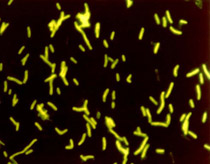Use bacteria to produce biofuels
The ability to turn CO2 into methane by electric currents of some species of bacteria can help humans create huge renewable sources of renewable energy.
Wind energy is unstable, while solar cell power output drops at night or cloudy days. Therefore, households who use wind power or solar cells often face the situation of 'lack of excess' during the use of electricity.
Scientists have come up with many solutions to deal with this instability, such as using better batteries or redesigning the grid. An idea that is of interest is for bacteria to 'eat' excess electricity so that they generate methane from CO2. Bacteria can produce methane by combining electron CO 2 (electron). One can store methane and then burn it when it needs electricity. This method is environmentally friendly because bacteria take CO 2 from the air.

Methanobacterium formicicum has the ability to turn CO 2 into methane. Photo: icsp.org.
The above method came about after scientists at the University of Pennsylvania discovered the ability to turn CO 2 into methane of a bacterium called Methanobacterium palustre. When living on the cathode (cathode) of an electrolyte, the bacterium can 'eat' electrons and use the energy of electrons to convert CO2 into methane. Some other bacteria also have similar abilities.
Tom Curtis, an environmental expert at New England University, thinks that using bacteria will bring economic benefits. Since the metal is not involved in the process of turning CO 2 into methane, the method will be very low cost.
"80% of the electricity used to turn CO2 into methane will be recovered when we burn methane. You cannot recover all the electricity used, but that is a common problem for all energy storage methods. ", Curtis said.
If CO 2 that people use in the process of making methane comes from the chimneys of power plants or even air (thanks to complex techniques), the method of using bacteria can become a way for children. people remove carbon dioxide from the atmosphere. Curtis is optimistic about the potential of the new method by suggesting that the commercial applications of this method will come out in a few years.
Many other techniques use bacteria to produce hydrogen fuel instead of methane. However, the time of hydrogen has yet to come. 'Those methods are great, but hydrogen is not compatible with our infrastructure. Metan does that, ' Curtis said.
- Catch bacteria that provide fuel for cars
- Producing chemicals and biofuels from wood biomass
- Bacteria and energy
- Successfully producing the cheapest biofuels in the world
- Biofuels from brewery waste
- Biofuels can increase pollution 4 times
- Biofuels cause controversy over the food crisis
- Biofuels threaten food security
- Pharmaceutical originated from the sea
- Bacteria can produce rain
- Producing car 'gasoline' from distillers
- Production of biofuels thanks to microwaves
 Why do potatoes have eyes?
Why do potatoes have eyes? 'Tragedy' the world's largest carnivorous life: Death becomes ... public toilet
'Tragedy' the world's largest carnivorous life: Death becomes ... public toilet Tomatoes were once considered 'poisonous' for 200 years
Tomatoes were once considered 'poisonous' for 200 years Detecting microscopic parasites on human face
Detecting microscopic parasites on human face